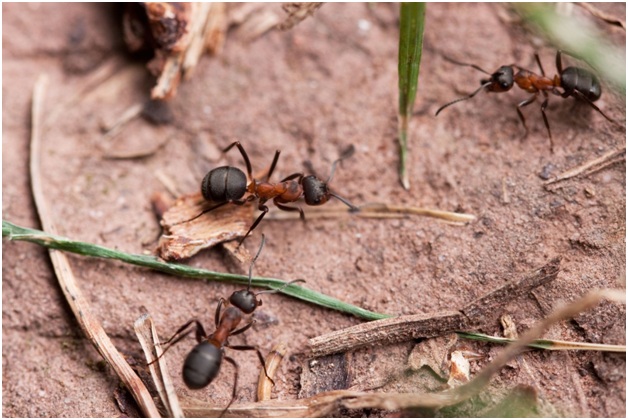European Fire Ants, Making Their Way to Canada

As if colonies comprised of millions of fiery Argentine ants, carpenter ants, pavement ants, Pharaoh, or thief ants weren’t already a full plate for Canadian homeowners, a non-native species – more aggressive and potentially dangerous to humans, pets, and livestock – has been making its way into our country. The European fire ant, Myrmica rubra, a common species of red ants found all over Europe and in some parts of Asia, has first been spotted in British Columbia in 2010 and has since been reported in several regions in Richmond, Ontario, Burnaby, Toronto, Victoria, North Vancouver, and Courtenay. Although they share the same name, they are only distant relatives of the “real” fire ants of the Solenopsis species.
Despite their similarity to native species in appearance, experts warn that the European fire ants are more difficult to kill and can deliver a vicious sting to both humans and animals even without being provoked. They are also very territorial and can swarm in the thousands when disturbed, preferring areas near water, irrigated lawns, deciduous forests, old fields, under rocks, and 3-4 feet down in moist soil. A single queen colony can have up to 150,000 ants, while colonies with multiple queens will often exceed 300,000 in population and up to four nests per square meter.
And they spread like fire. Once they’ve settled into a favorable habitat, they will infiltrate the area in a matter of days, most of the times through movement of infested garden materials, such as soil, potted plants, and mulch. The colonies spread naturally through “colony budding,” a colony multiplication process by fragmentation of primary nests (one or more queens leave a nest with a group of workers to set up a new one, typically within a one-mile range from the main nest).
The government is aware of European’s fire ant presence in the aforementioned urban areas in Canada and has initiated collaboration with several local and national non-government organizations, as well as fire ant experts from all over the country, to determine the most effective control options for current and future invasions. Their joint action plan objectives, as stated in the Fire Ant 2012 Planning Session Report (June session), include:
• Improve mapping of fire ant distribution across the country
• Improve communication and education
• Identify relevant legislation/regulations
• Increase research
• Raise awareness
How Can Their Pillage Be Stopped?

Currently, no effective control method has been developed by Canadian authorities for the management of European fire ants. Boric acid, one of the chemicals of choice successfully implemented by many urban pest control programs, has had limited success in controlling European fire ant populations so far. According to the report, “The problem associated with using boric acid commercial baits is that the concentration of boric acid is too high, ranging from 3-5%, whereas pesticide baits containing 0.25-1% of boric acid have been found to be a more successful control.
There are also other difficulties associated with the use of pesticides for European ant control, including correct bait placing in infested areas (not placing the right amount of bait will render the treatment useless). Many times, homeowners may encounter dead ants, but will see no decreased activity in colonies. Standard pesticides may work to decrease European fire ant populations, but there are two problems: one, the queen of the colony must be directly affected for the colony to die, and two, ants send their oldest and most disposable workers out to forage, so the dead ants you’ve encountered would not have had many days left to live anyway.
Limit the Chance of Infestation

Ants are a known problem in Canada this time of year, but this season’s hot, dry weather appears to be particularly favorable for the obnoxious critters. In order to decrease the chances of an infestation, there are several steps recommended by professional ant pest control company you can take, including:
• Cutting the grass short
• Removing clutter and debris from backyard
• Placing paving rocks on top of gravel opposed to soil
• Turning over garden beds during seasons with intensely cold and dry weather
Most of us don’t typically pay any attention to these tiny creatures, and we generally consider them harmless, even when they’re crashing our picnic parties or infesting our homes. But the biting and stinging European fire ants require special attention, as they have been known to terrorize homeowners, hikers, picnickers, or just about anyone who unknowingly disturbs one of their nests.
Although there haven’t been many deaths caused by fire ants, they do deliver a painful bite and a venomous sting that could take days to heal, often accompanied by swelling, redness, nausea, vomiting, painful blisters, and burning sensation. Keep an eye out for these nasty critters and hire a professional pest control company to ensure their proper control and prevention, making sure they’ll never again be a problem for your lawn and landscape.
About the Author:
Daniel Mackie, co-owner of Greenleaf Pest Control, is a Toronto pest control expert well-known as an industry go-to guy, an innovator of safe, effective pest control solutions, and is a regular guest on HGTV. Mackie, along with business partner Sandy Costa, were the first pest control professionals in Canada to use detection dogs and thermal remediation for the successful eradication of bed bugs. In his free time, he is an avid gardener.



You must be logged in to post a comment.